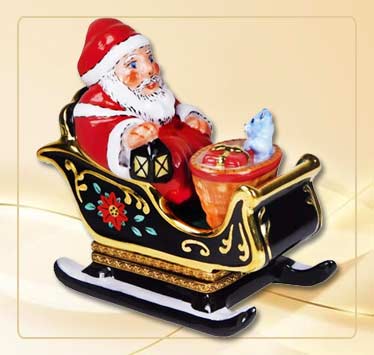Limoges Boxes Historically Collected by European Royalty

“Collecting is a world habit. Collectors practice it consciously and with a definite, recognized aim. The rest of us practice it more or less unconsciously.” - Arnold Bennett (1861-1931)
The Origin of Painted Porcelain
The Chinese were the first to produce hand-painted porcelain objects in the second century B.C. The Europeans greatly admired these works of art when in 1520 decorated porcelain products were first imported to Europe. With great efforts to create the white porcelain, by 1712 the manufacturing process was begun in Europe. But due to a shortage of the key ingredient for fine porcelain – "Kaolin” clay – the fine production was not yet possible.
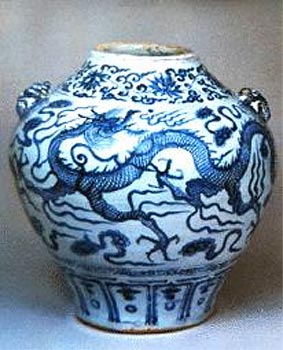
Early Chinese hand-painted blue and white porcelain
In 1768, a very large deposit of the finest Kaolin in Europe was discovered in the vicinity of Limoges, France. Since the 12 th century, Limoges had been famous for enameled artworks and stained glass, and the town was also an established regional trading and manufacturing center. The abundant forests in the region provided wood for the porcelain firing kilns, and the Vienne river supplied plentiful water and transportation. These key factors plus the availability of many skilled local artisans, attracted designers and entrepreneurs from throughout Europe who established their individual manufacturing ateliers, some of which gained world famous trademarks which are revered to this day.
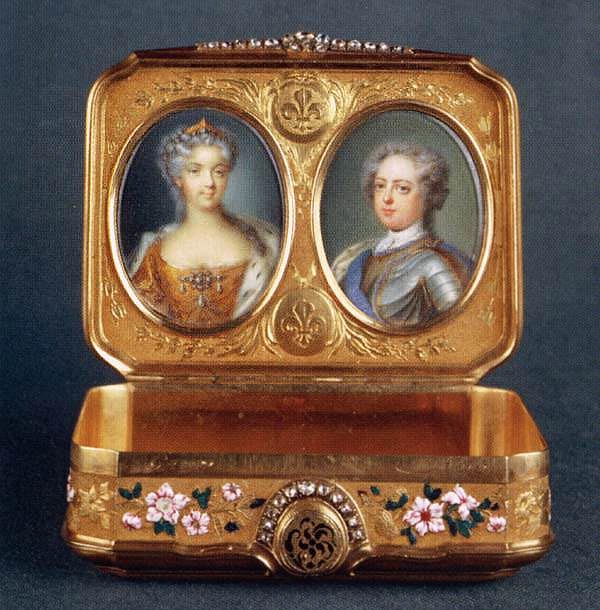
An early French Gold snuffbox with diamonds and hand-painted portraits. From the collection at Musée du Louvre, Paris. (Circa 1725-26)

Oval Gold, enamel and diamonds French hand-painted Limoges box. From the collection at Musée du Louvre, Paris (Circa 1762-63)
Collecting Porcelain Boxes
Passionate collectors travel the world and spend thousands for just one addition to their collection. This is not a new phenomenon, especially when it comes to the French porcelain Limoges boxes - snuff boxes, as they were originally called.
The French aristocracy had a great taste for all things extravagant. As snuff taking had become reflective of one's social breeding in the 17th century, the container for the snuff had to also reflect the owners status symbol. Thus, the French nobility began collecting these precious objects and proudly carried them on their person.
Early collectors were greatly enthused about their tiny possessions. As miniature symbols of power and prestige, snuffboxes became objects of obsessive collecting by gentlemen as well as ladies. Here are some of history’s most famous – and infamous – collectors and enthusiasts:
Marquise de Pompadour (1721-1764)
Known more commonly as Madame de Pompadour, she was born Jeanne-Antoinette Poisson to a middle-class family. She received an excellent education and was introduced to high society by a wealthy businessman. When she met the king at a ball in 1746, she left her husband and moved to the Versailles Palace to become one of Louis XV’s mistresses as well as his political adviser and private secretary. Madame de Pompadour exerted her influence and her taste in the court and at Sevres, the world-famous porcelain factory near Paris. As an ardent supporter of the Royal Manufactory, she placed frequent special orders for porcelain snuffboxes and is rumored to have had one for every day of the year. She was honored by some porcelain makers, who used her spaniel as an image for a snuffbox. A Mennecy box (a porcelain box made by the famous French Mennecy soft-paste porcelain factory established in 1695), in the form of a lady reclining on military equipment, is believed to be a satirical depiction of the power-hungry marquise.


Madame de Pompadour was an ardent supporter of the porcelain industry and a great collector of porcelain Limoges boxes. She is rumored to have had one for every day of the year!
Marie Antoinette (1755-1793) & King Louis XVI (1770-1793)
To the nobility, snuffboxes were symbols of affluence. A gift of a luxurious French Limoges snuffbox was the perfect method of commemorating a special event or personage. Considered lavish pieces of jewelry, not only each piece was exquisitely hand-painted but many boxes used gold for the metalwork and hinges as well as precious stones in some designs.
Marie Antoinette was the youngest daughter of the famous Habsburg Empress Maria Theresa of Austria. At the age of 14 years, she was given in marriage to Louis-Auguste, the grandson of Louis XV and the heir to the throne of France. In 1774, when her husband ascended the throne as Louis XVI, Marie Antoinette became Queen of France.
King Louis XVI and Marie Antoinette, the famous French rulers whose lives were cut short by the guillotine, were the subjects and recipients of numerous Limoges snuffboxes.

Portraits of Marie Antoinette and King Louis XVI of France
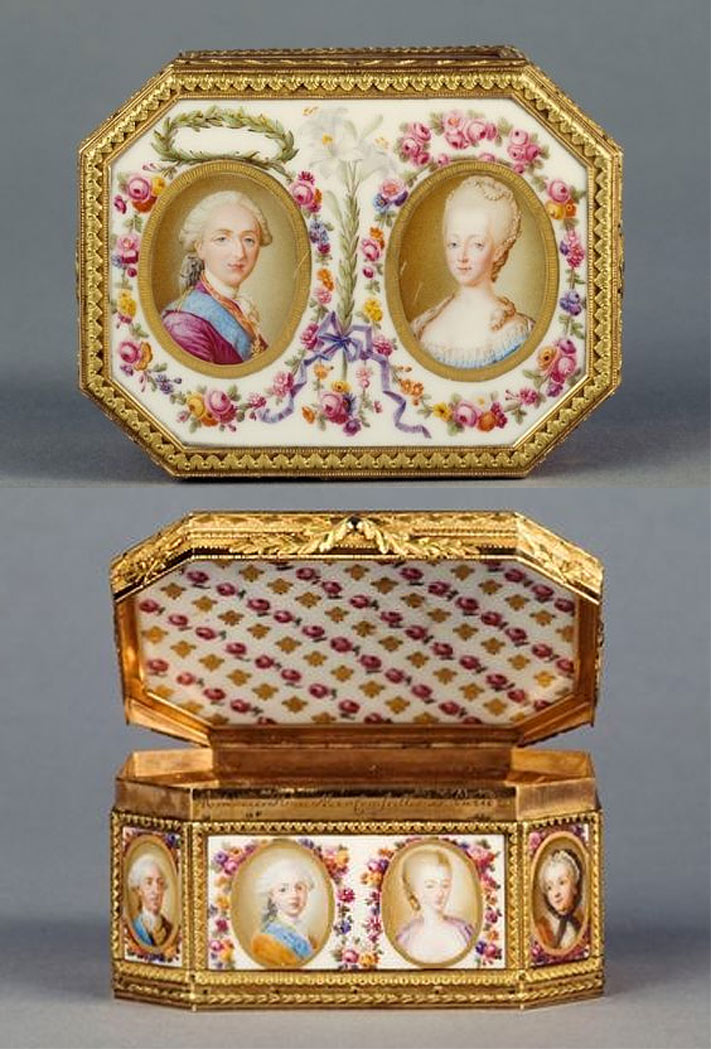
A truly magnificent Limoges box, crafted of gold and soft porcelain, created for Louis XVI's coronation. The Limoges snuffbox is exquisitely hand-painted with portraits of Marie Antoinette and Louis XVI at the top with additional portraits of the royal family all around.

A Louis XVI large gold and diamond mounted snuff box with a hand-painted porcelain portrait of the king. (circa 1779)
Maria Louisa of Parma (1751-1819)
Maria Louisa of Parma, the wife of King Charles IV of Spain, was Queen consort of Spain from 1788 to 1808. She was the youngest daughter of Duke Philip of Parma and his wife, Louise Elisabeth of France, who was King Louis XV's eldest daughter.
Maria Luisa was regularly painted by the famous Spanish artist Goya. By her contemporaries, the queen was often described as an ugly, vicious, and coarse woman who greatly dominated the king.
This portrait of Princess Maria Luisa of Bourbon-Parma was painted by the French painter Pécheux to be presented to the family of her fiancé, the Prince of Asturias, later Charles IV of Spain. In this portrait, Maria Luisa, who was granddaughter of both Philip V of Spain and Louis XV of France, wears the decoration of the Hapsburg order of the Croix-Étoilée pinned to her dress and holds a snuffbox with a miniature of her future husband in her right hand.
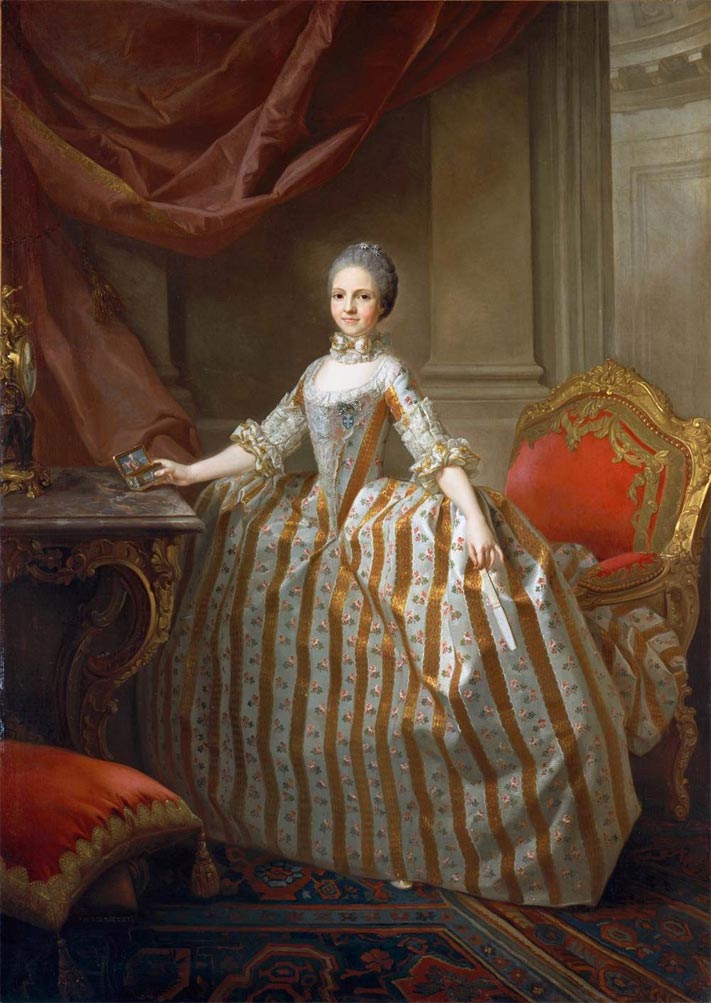
Maria Louisa of Parma is holding a tabatiere a cage containging a miniature painting presumed to be of her husband
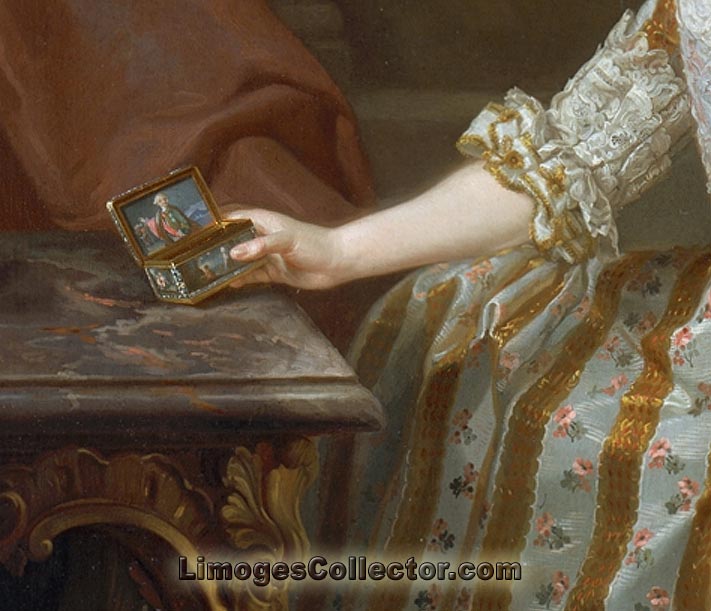
Phillippe d’Orleans (1674-1723)
Upon the death of Louis XIV, the Parisian parliament installed the Sun King’s enemy, the Duke of Orleans, as regent for Louis XV from 1715-1723. An ardent snuffer himself and an admirer of beautiful objects, Phillippe greatly encouraged the snuffbox makers. Despite the fact that France was virtually bankrupt, he fulfilled his passion for snuffbox collecting without restraint. Legend has it, that Phillipe d’Orleans also was one to have a snuffbox for every day of the year!

Philippe d'Orleans, the Duke of Orleans, regent for Louis XV from 175-1723, an avid snuffbox Limoges collector

A rectangular gold and enamel snuff box with rose-cut diamonds, decorated with the cipher of Henri V de Bourbon and presented to Philipe d'Orleans (circa 1855). The interior of the lid is engraved 'Donné par Monsieur le / Comte de Chambord/ au Baron de Schwiter / 1855' (Given by Mr. Count of Chambord / Baron of Schwiter)
Catherine the Great (1729-1796)
Born a German princess, Catherine ruled as empress of Russia from 1762 until her death in 1796. Driven by a zeal for knowledge and a quest for the throne, Catherine propelled herself to the role of Empress through the sheer power of her intellect, cunning, and resolve. Reining over a golden age of Russian culture, for thirty four years, Catherine founded what would become the State Hermitage Museum and transforming St. Petersburg into one of Europe’s cultural centers with a large collection of finely-crafted decorative art pieces.
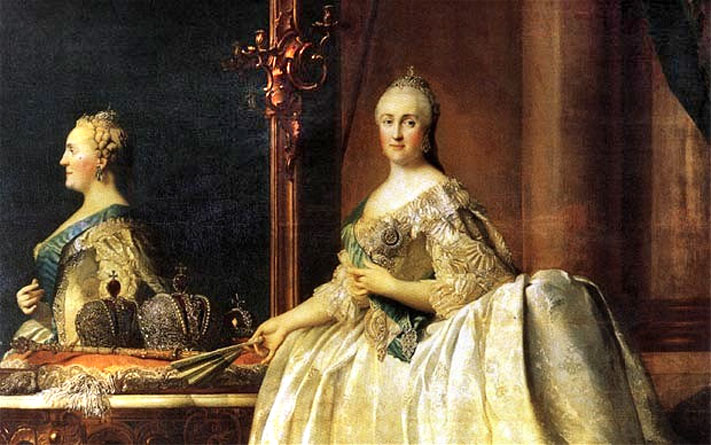
A dazzling array of decorative art in gold, silver, porcelain, and enamel reveals the power and patronage that marked the reign of Catherine the Great, one of Russia’s foremost art collectors and shrewdest political and cultural leaders. Her collection of snuffboxes was more likely international. Russian boxes tended to reflect the styles set at Meissen. During her reign "envelope" boxes, often with French inscriptions, were in vogue. The bottoms of boxes were often imprinted with the Family's coat of arms.
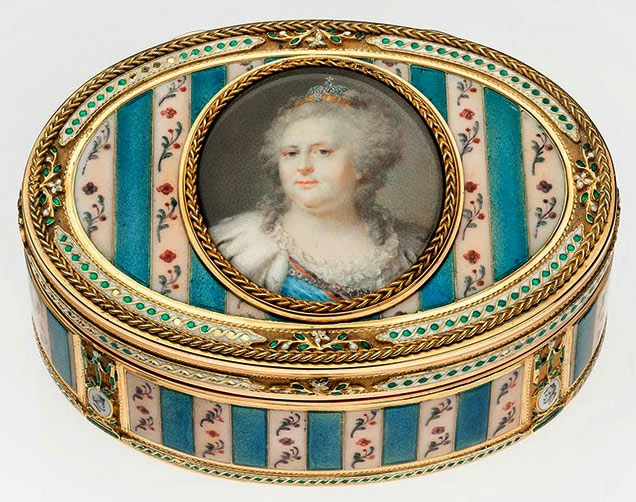
Oval snuffbox, crafted of gold and enamel and set with precious gemstones with a hand-painted porcelain miniature of Catherine the Great. (Circa 1775)
Napoléon Bonaparte (1768-1821)
An inveterate snuffer and collector of snuffboxes, the Emperor of France (1804-14) is also rumored to have had a snuff box for every day of the year. Because he suffered from occasional bouts of choking/coughing, Napoleon also carried a bonbonniere at all times and used the chocolates to quell his cough. Count Corti, in The History of Smoking (1931), commented that “If one could collect all of Napoleon’s snuffboxes in one room and arrange them in chronological order, they would form a picture history of his life.”
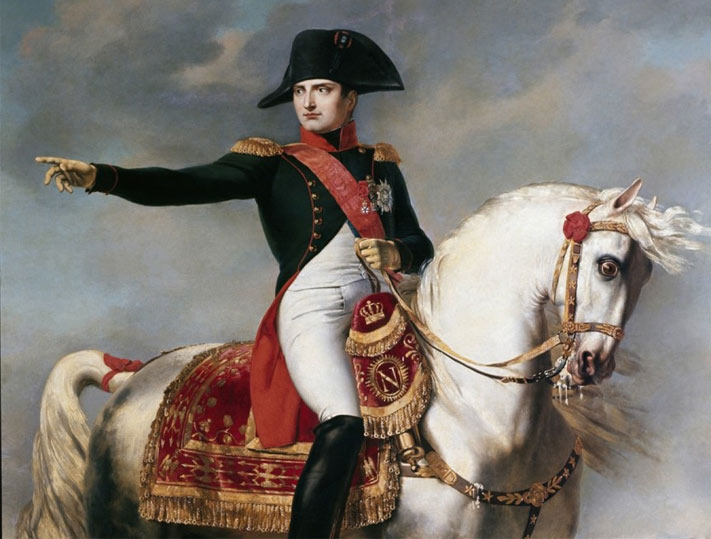
Napoleon was one of history's great snuffbox collectors and the subject of many portrait boxes.
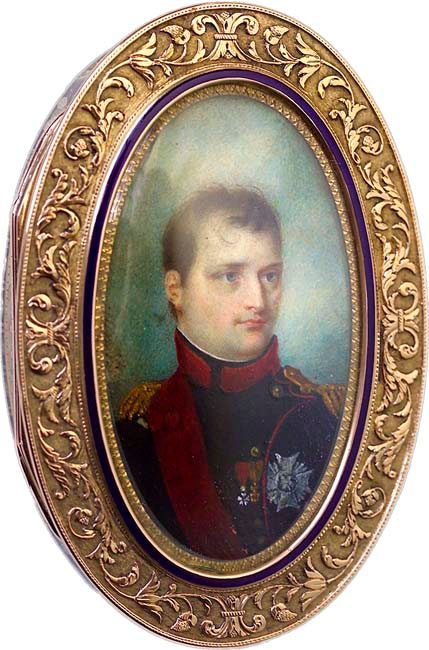
A snuffbox commissioned by Napoléon Bonaparte, on display at the Green Howards Regimental Museum in Richmond, United Kingdom
Various Shapes
As snuff-taking achieved cult-like popularity all over Europe, the snuffbox took on greater importance. At the height of its popularity, the snuffbox became as revered as the habit itself. The mere appearance of this tiny object revealed the position, taste and wealth of its owner. Just like fans, canes and swords, a beautiful tabatiere was meant to be flourished and made part of one's elegant attire and persona.
Besides the traditional squares and rectangles, Snuff boxes were made in various interesting and symbolic shapes. The shell, reflecting the rhythm, elegance and fantasy of the times, a decorative symbol of the 18th century, became a popular subject for porcelain snuffboxes.
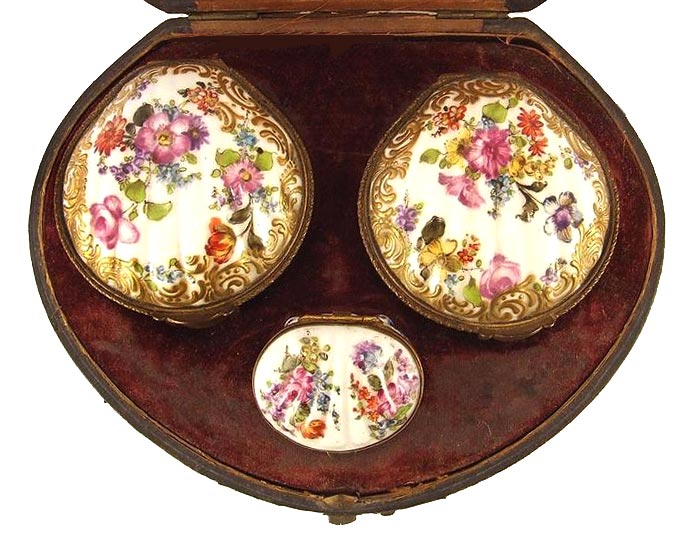
A Collection of three shell-shaped porcelain snuff boxes from the 19th century. Each Limoges porcelain snuffbox is covered with hand painted floras and raised gold enamel scrolling motifs.
Another important symbol of the ancien regime was the pug, the favored lapdog that was synonymous with aristocratic society. Because of the pug's unflagging popularity, savvy box makers created snuffboxes in their images, either in paint or molded porcelain.
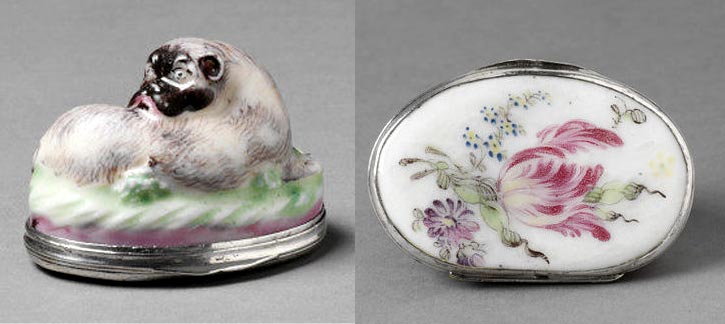
A Soft-paste porcelain Limoges porcelain snuffbox in the shape of a reclining Pug Dog, hand-painted with enamels with silver mount (Circa 1760)
Snuffboxes were so much a requirement of luxurious attire, even those who didn't snuff were advised to carry one nevertheless, according to a 1783 book of etiquette. Portrait painters during this period often included a snuffbox in their paintings as a symbol of elegance and fashion.
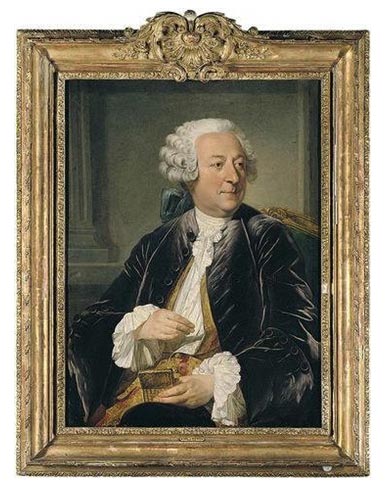
Portrait of a gentleman with a white powdered wig, attired in a purple velvet jacket, holding an open snuffbox - by Jancques Andre Joseph Aved (1702-1766)
By the middle of the 18th century, there were snuffboxes for everyday use as well as those for elegant occasions. Accordingly, the richness of the boxes had to correspond with that of the rest of the costume and environment. Some dandies changed boxes daily, or according to their mood. The truly stylish would have as many snuffboxes as outfits. A 1782 issue of the Tableau de Paris reported, "One has boxes for every season. The winter box is heavy and the summer box light. And this refinement has been so exaggerated that boxes are changed every day and it is by this distinguishing feature that one recognizes the man of taste."
Appropriately, being such a treasured item, snuffboxes became the perfect gift for life's most important occasions in the 18th century. These charming Limoges porcelain boxes were used for political purposes and were given by royalty as a mark of their favor, and a visible token of royal esteem. Such gifts were often gold boxes that contained hand-painted porcelain portraits of the king or other aristocratic figures.
Snuffboxes were also the traditional coming-of-age gift from father to son and could be used as a legacy left by a dead friend. Indeed, by the end of the 18th century, it became clear that snuff - as well as the container it was held in - had created a culture uniquely its own. If there were one image to characterize the entirety of rococo society, it would be that of a gentlemen of fashion delicately pinching snuff from an elegant tabatiere.
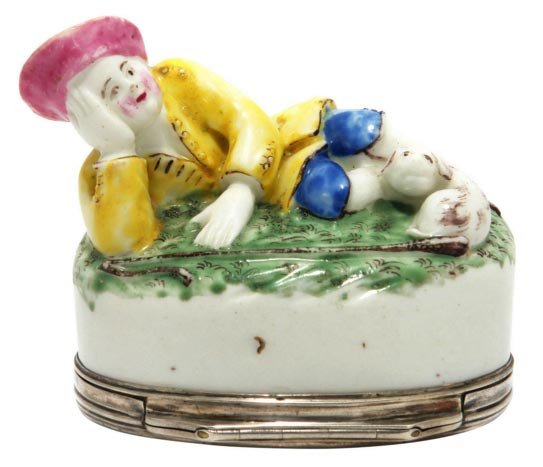
Mennecy porcelain snuff box in the shape of a reclining shepherd boy and his dog hand-painted inside and out with silver mounts. (Circa 1760)

Porcelain Limoges snuff box of the head of Neptune, modeled after a Meissen original of the mid 18th century. (Circa 1880)

Porcelain Limoges snuffbox in the shape of a man's leg wearing trousers and stockings that gather at the knee with a stylish heeled court shoe. The snuffbox opens at the top with a silver gilt mount. (Circa 1790)
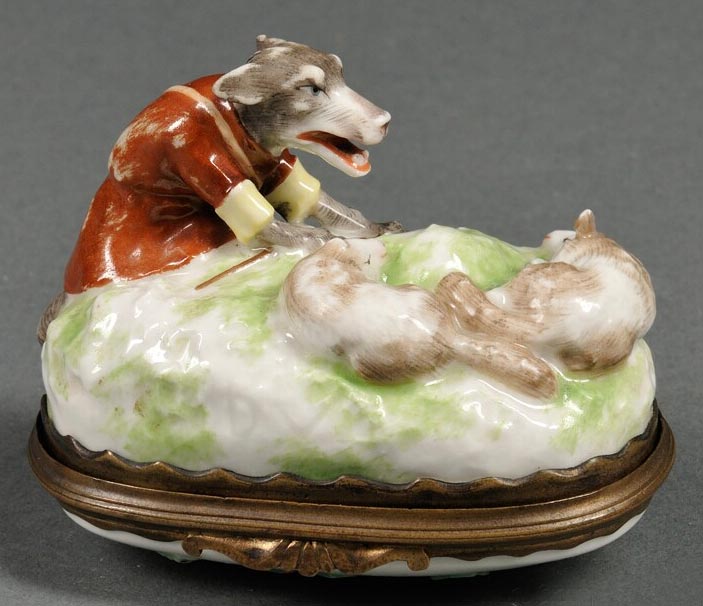
A mid-19th century French Mennecy porcelain snuffbox portraying a wolf in shepherd's clothing approaching two sleeping sheep.
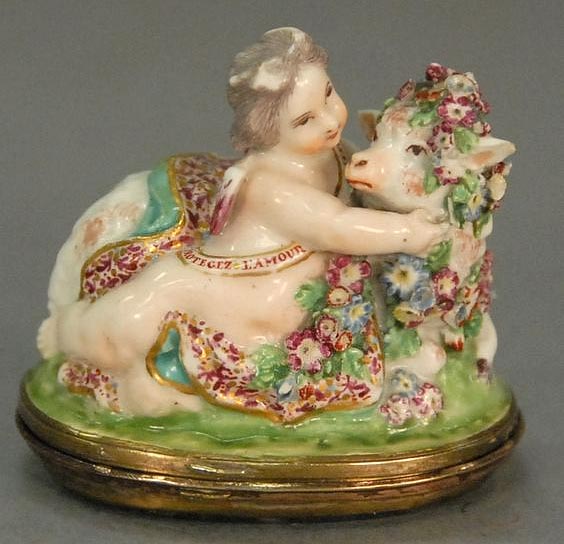
French porcelain bonbonniere in the shape of a cherub putting garlands of flowers on a sheep (Circa 1760)
Collecting Limoges boxes, a passion for the aristocrats and nobility for centuries, continues strongly to this day. Limoges boxes have enjoyed a great degree of following especially in the United States for the past century and the enthusiasm and delight in collecting continues to grow. Collectors enjoy collecting and expanding their collection of the antique and retired pieces as well as exceptional new and exclusive Limoges boxes that continue to be produced by master artisans in Limoges, France.
We hope you have enjoyed this post and that it has increased your appetite for enhancing your own collection. Please check out our extensive selection of French Limoges boxes to find many tempting Classic and Traditional Limoges boxes as well as numerous contemporary styles in every theme and category.
About LimogesCollector.com
LimogesCollector.com, offers a wide variety of high-quality French Limoges boxes crafted by expert artisans in Limoges, France. We specialize in importing directly from the top producers in Limoges and are authorized dealers of various top Limoges brands We are also proud to be the exclusive authorized dealer for Beauchamp Limoges. Our collection is constantly updated with the latest creations as well as retired and rare Limoges boxes. With over 5,000 styles available, you can easily find Limoges boxes related to any subject or interest. Our vast collection also offers a multitude of Limoges box gift options for any occasion or recipient.
Our website also offers a personalization service which makes your Limoges purchase much more meaningful for any occasion. You can also choose our professional giftwrap service for a beautifully presentable gift for any occasion.
So, take a little time to check out our website and find the pieces that spark your interest and that you'd love to add to your collection.
Did you find this post informative? We would love to hear your comments.






